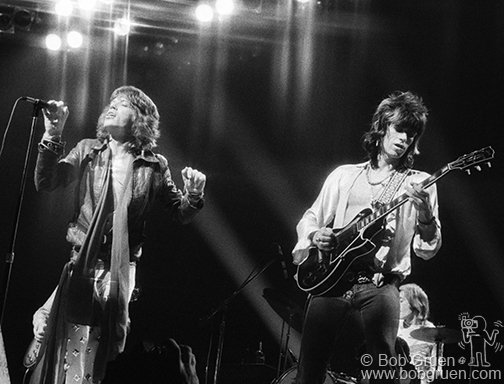Bob Gruen, Mick Jagger & Keith Richards, MSG, NYC - 1972. Courtesy of the artist, ©️ Bob Gruen/www.bobgruen.com.
The titans of rock music are depicted as Gods through the legendary lens of Bob Gruen.
Written by: Max Weiner
Gone are the days of “rock and roll.” The music isn’t dead, but the swashbuckling, passionate culture of its heroes is certainly something of the past. With social media and phones, the world of music has become completely different. With each passing year, we grow further from one of the most iconic periods in music history and cultural history.
Bob Gruen, Led Zeppelin, NY - 1973. Courtesy of the artist, ©️ Bob Gruen/www.bobgruen.com.
Bob Gruen is a shepherd for this culture, and through his iconic photographs rockstars become more than musicians; they became Gods. At the A Gallery for Fine Photogprahpy in New Orleans, the aptly-titled Rock & Roll presents us with a fantastic look at some of Gruen’s most endearing and enduring works, from The Beatles to Led Zeppelin. In his prime, Gruen separated himself from the pack by getting unprecedented access to some of the most high-profile acts in the world, and through his lens fans became obsessed with the imagery and oeuvre of rock and roll stars. His images highlight superstardom like few artists could and shows us the true power of both unmatched celebrity and immense talent. The series opens on April 24th and has a scheduled closing date of August 31st.
Nowadays, celebrities use their social media platforms to show us their worlds in a direct and streamlined way, creating an easy path from consumer to artist. In the 1970s, getting an exclusive picture of Led Zeppelin seemed nearly as impossible as guitarist’s Jimmy Page’s on-stage sonic heroics. Bob Gruen used this leverage to give the world a supply for the demand, and looking at his output it becomes clever why he has such an important place not just in rock history, but photographic history. Take his uber-iconic image of the aforementioned Led Zeppelin standing in front of their band’s plane, all four of them staring into our Plebian eyes like Gods among men. The biggest band on Earth needed to feel like the biggest band on Earth, and Gruen took advantage of that and produced exactly what people wanted to see; this was his true mastery as photographer. Their talent and image was so ripe that it needed to be shown to the world.
Bob Gruen, John Lennon, NYC - 1974. Courtesy of the artist, ©️ Bob Gruen/www.bobgruen.com.
Even with an unmatched ability to show the broadness of a rock and roller, Gruen also used his camera to capture some of the more intimate moments of the industry’s brightest stars, notably John Lennon. As one of the Fab Four, Lennon was more than a musician; he was a deity. Gruen's subtle photographic style injected human elements into the man responsible for writing some of the most important and everlasting songs ever. His words were scripture, but he was just as ordinary as any of us through Gruen's lens. Releasing the two sides of Gruen's talent is important in showing his skill as an artist and the industry. Rock & Roll is truly an experience unlike any other.
Bob Gruen, Tina Turner, Honka Monka Club, NYC - 1970. Courtesy of the artist, ©️ Bob Gruen/www.bobgruen.com.










